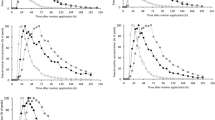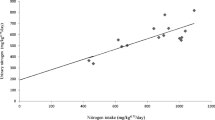Abstract
The gastrointestinal tract of omnivores such as bandicoots (Marsupialia: Peramelidae) must be able to process foods as different as invertebrates, fungi and plant material. We studied the mechanisms involved in the utilisation by captive northern brown bandicoots (Isoodon macrourus) of insect larvae and milled lucerne (Medicago sativa) hay incorporated into a basal diet of a commercial small carnivore mix. Animals on the plant-basal mix digested less dry matter, energy, lipid, fibre and total nitrogen, but consumed 79% more dry matter than those on the insect-basal mix. Consequently intake of digestible energy (i.e. energy absorbed) was not significantly different between diets. Mean retention time (MRT, the mean time a marker remains in the tract) of a large particle marker was shorter on the plant-basal mix, reflecting its higher intake, but MRT of a solute marker was not significantly different between diets. Consequently the solute marker was retained longer than the particle marker on the plant-basal mix, indicating selective retention of solutes and very small particles in the caecum on this diet. This was confirmed by a higher proportion of small particles in the caecum than the distal colon of road-killed I. macrourus. Thus the main responses by I. macrourus to the plant-basal mix appeared to be an increase in gastrointestinal tract capacity (from radiographic evidence), selective retention of solutes and very small particles in the caecum, and facilitated passage of less tractable large particles through the colon. As a consequence, food intake was higher on the plant-basal mix, which compensated for its lower digestibility, and intake of digestible energy was similar to that on the insect-basal mix. This considerable flexibility of the morphologically rather simple digestive tract of northern brown bandicoots helps to explain their ability to cope with naturally variable diets consisting of mainly invertebrates in summer to much more plant and fungal material in winter, and to survive in nutritionally dynamic environments such as heathlands where there can be dramatic changes in food type and availability following periodic wildfires.
Similar content being viewed by others
Author information
Authors and Affiliations
Additional information
Accepted: 14 April 1999
Rights and permissions
About this article
Cite this article
McClelland, K., Hume, I. & Soran, N. Responses of the digestive tract of the omnivorous northern brown bandicoot, Isoodon macrourus (Marsupialia: Peramelidae), to plant- and insect-containing diets. J Comp Physiol B 169, 411–418 (1999). https://doi.org/10.1007/s003600050237
Issue Date:
DOI: https://doi.org/10.1007/s003600050237




